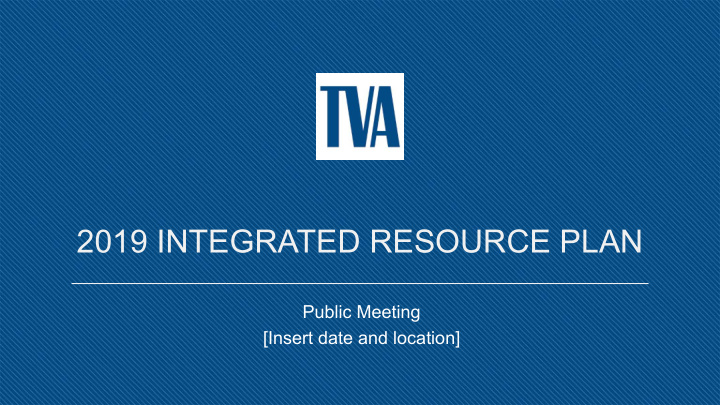



2019 INTEGRATED RESOURCE PLAN Public Meeting [Insert date and location]
TVA’s Mission Energy Environment Economic Development Provide affordable electric Serve as a catalyst for Act as a steward of the power throughout the sustainable economic Valley’s natural resources Tennessee Valley development | 2
What is an Integrated Resource Plan? • Shapes how TVA will provide low- cost, reliable electricity over the next 20 years • Enhances TVA’s ability to add more The final IRP will serve renewables and distributed energy as a compass that resources (DER) provides broad • Informs TVA’s next Long-Range direction, rather than Financial Plan as a GPS that provides a specific route. | 3
Why are we updating the IRP now? The utility marketplace is changing and we need to proactively plan for the future! 1 2 3 Consumer behaviors and Companies are committing Distributed energy resources preferences are changing to renewables (DER) introduce fundamental change | 4
• System flexibility • Distributed energy resources • Portfolio diversity | 5
TVA’s IRP Planning Process We are here! Fall Summer Spring Summer/Fall Winter Spring/Summer Winter/Spring 2017 2019 2018 2018 2018 2019 2019 Develop Identify Analyze & Present Initial Incorporate Prep Scoping ** Inputs & Preferred Evaluate Results ** Input Framework Plan/Direction Public Engagement Period (** indicates timing of Valley-wide public meetings) 2019 Integrated Resource Plan | 7
Stakeholder and Public Involvement When it comes to your electricity, what is important to you? That it's reliable? Low-cost? Environmentally sustainable? Public Scoping Comments | 8
Scenarios and Strategies External Factors Shaping the Environment TVA’s Response & Portfolio Goals Scenarios Strategies 1 - Current Outlook A – Base Case 2 – Economic Downturn B – Promote DER 3 – Valley Load Growth C – Promote Resiliency 4 - Decarbonization D – Promote Efficient Load Shape 5 – Rapid DER Adoption E – Promote Renewables 6 – No Nuclear Extensions | 10
Integrated Resource Planning Process | 11
Metric Categories Cost Long-range cost of the resource plan and average system cost Financial Risk Measures the uncertainty around the cost of various plans Environmental footprint of the resource plans, including air emissions Environmental Stewardship and water, waste and land use impacts Portfolio’s ability to ramp up and down to respond to changes in Operational Flexibility demand Valley Economics Measures per capita income and employment changes | 13
Preliminary Results • There is a need for new capacity in all scenarios modeled • All portfolios show significant levels of solar expansion • Energy efficiency (EE) and demand response (DR) levels are relatively similar across the portfolios • No nuclear resources are added due to size and high capital cost, except for small modular reactors as part of the Promote Resiliency strategy • No wind or hydro resources are added | 14
Strategy Performance | 18
Draft Environmental Impact Statement: The IRP & the Tennessee Valley Environment Overview Environmental Conditions in the Tennessee Valley Environmental Impacts of the 2019 IRP | 19
Purpose and Approach of the EIS Purpose: • Ensure environmental impacts are considered in decisions related to long- term power planning • Include public involvement • Comply with National Environmental Policy Act (NEPA) Approach: • System-wide assessment of environmental impacts • Site-specific studies of potential plant retirements • Establish a framework to study future site-specific actions | 20
Evaluating these Key Factors • Air quality • CO 2 emissions • Water resources We strive to be good • Fuel requirements stewards of the • Waste production Valley’s resources. It’s part of who we are at • Land requirements TVA. • Employment and per capita income | 21
Observations in the EIS • Long-term decreases in: - Air pollutant emissions - CO 2 emissions - Water use and consumption - Coal consumption and ash production • Potential for local socioeconomic impacts associated with plant retirements • Strategies C, D, and E have lowest impacts to most environmental resources, but largest land requirements | 22
We’d like to hear from you! The public comment period is open until April 8, 2019. Share your feedback with us online, in-person or by mail! • Submit a comment form at tonight’s public meeting • View our interactive report and submit a comment online, visit tvairp.com • Listen to our webinar, taped live on February 26 th • Mail-in a comment form: Hunter Hydas IRP Project Manager Tennessee Valley Authority 1101 Market Street, MR-3C Chattanooga, TN 37402 • Email us at irp@tva.gov | 24
Recommend
More recommend